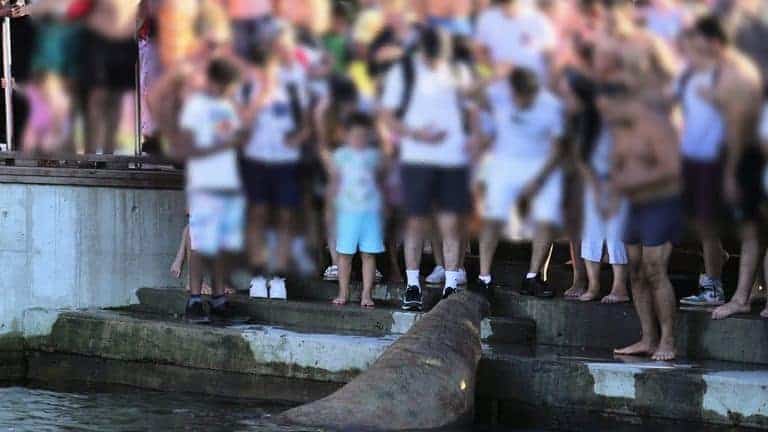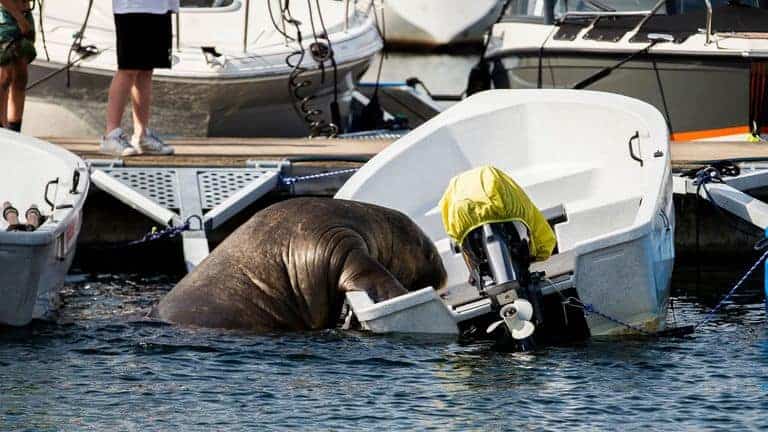
Our team were devastated yesterday following the news that the walrus known as ‘Freya’ – who visited Northumberland and the Shetland Isles near the end of 2021 – had been put to sleep near Oslo by the Norwegian Directorate of Fisheries after crowds of people ignored their warnings to leave her alone.
Freya has been present in Europe since 2019, and last year went on a tour passing through Germany, the Netherlands and the UK before returning to Norway where she has spent most of her time. Recently she developed a liking for hauling out on boats, causing some damage, which is a situation our own team is entirely familiar with having dealt with exactly this situation with another walrus called ‘Wally’, who visited the UK and Ireland last year.
In Wally’s case our team, in collaboration with many other organisations and authorities, were successfully able to mitigate for this behaviour by providing an alternative floating platform especially for him. We also had a range of potential deterrent techniques to trial as advised by colleagues at the US National Oceanographic and Atmospheric Administration in Alaska who have experience with walruses too. Additionally we had a continuous physical presence on the scene to reinforce the messaging to the public about giving him plenty of space to prevent disturbance and risk of accidents too. Thanks to these efforts, and those of our colleagues at Seal Rescue Ireland when he subsequently moved on to them, he was able to safely pass through on the next step of his journey up to Iceland and beyond. These efforts were later summarised into an international workshop report on out of habitat marine mammals and how to manage them.
When Freya began hauling out on boats and drawing crowds in Norway several weeks ago, we were contacted by individuals involved in wildlife welfare in the country for advice. We provided the workshop report and Wally’s case study, which were in turn passed on to the Norwegian Directorate of Fisheries, as they had begun warning that they would put her to sleep due to the potential for injuries to humans if people continued to behave in an out of control way. We had hoped that this advice and experience would enable the situation to be brought under control.
Sadly, we have been informed that the advice we provided appears to have been largely passed over by the Directorate. Although they did provide messaging to the public to give her space, this was not backed up by further mitigation efforts to improve the situation, and crowds continued to get within touching distance, throw things and try to get in the water with her. This ignorance from members of the public, along with the apparent lack of confidence from the authorities to attempt further mitigation and deterrent measures to keep her safe, has now resulted in her death.
Freya’s story now serves as a terrible benchmark for how some people will selfishly treat wildlife for their own benefit, as well as when they are an inconvenience to manage. This is exactly why organisations such as ours continually have to broadcast public messages for people to keep their distance from wild animals to prevent disturbance as the interactions are usually negative for the animals, and in this case for a healthy, enigmatic animal – fatal.
Impacts of climate change may make wandering walruses a more common occurrence around Europe as their habitat shrinks, and this type of situation could well occur again in the future. For us, approaching wildlife is a matter of curiosity or interest, for them it is a matter of life and death. The message is simple: give wildlife space.
A petition demanding answers has been launched HERE and we call on people to sign and share this widely.
Photos: Trond Reidar Teigan, Directorate of Fisheries.
